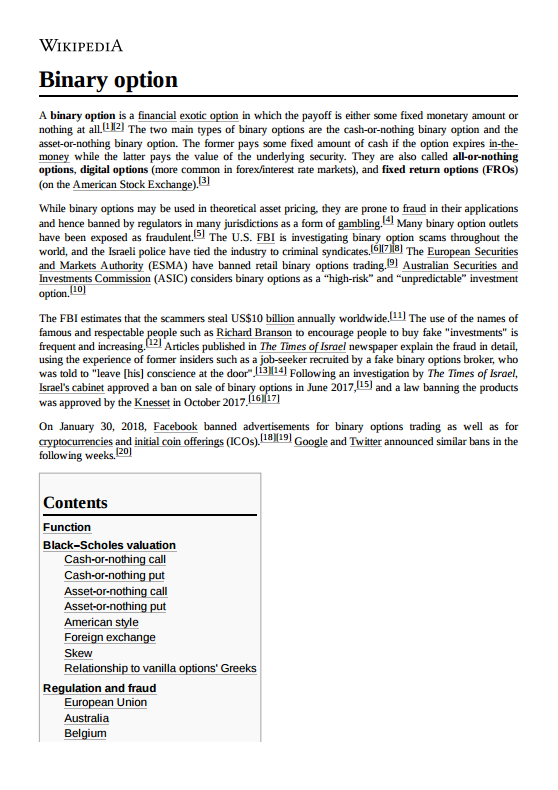WikipediA Binary option

Function
Binary options "are based on a simple 'yes' or 'no' proposition: Will an underlying asset be above a certain
price at a certain time?"
Traders place wagers as to whether that will or will not happen. If a customer
believes the price of an underlying asset will be above a certain price at a set time, the trader buys the
binary option, but if he or she believes it will be below that price, they sell the option. In the U.S.
exchanges, the price of a binary is always under $100.
Investopedia described the binary options trading process in the U.S. thus:
[A] binary may be trading at $42.50 (bid) and $44.50 (offer) at 1 p.m. If you buy the binary
option right then you will pay $44.50, if you decide to sell right then you'll sell at $42.50.
Let's assume you decide to buy at $44.50. If at 1:30 p.m. the price of gold is above $1,250,
your option expires and it becomes worth $100. You make a profit of $100 – $44.50 = $55.50
(less fees). This is called being "in the money".
But if the price of gold is below $1,250 at 1:30 p.m., the option expires at $0. Therefore you
lose the $44.50 invested. This is called being "out of the money".
The bid and offer fluctuate until the option expires. You can close your position at any time
before expiry to lock in a profit or a reduce a loss (compared to letting it expire out of the
money).
In the U.S., every binary option settles at $100 or $0, $100 if the bet is correct, 0 if it is not.
In the online binary options industry, where the contracts are sold by a broker to a customer in an OTC
manner, a different option pricing model is used. Brokers sell binary options at a fixed price (e.g., $100)
and offer some fixed percentage return in case of in-the-money settlement. Some brokers, also offer a sort
of out-of-money reward to a losing customer. For example, with a win reward of 80%, out-of-money
reward of 5%, and the option price of $100, two scenarios are possible. In-the-money settlement pays back
the option price of $100 and the reward of $80. In case of loss, the option price is not returned but the out-
of-money reward of $5 is granted to the customer.
Function
On non-regulated platforms, client money is not necessarily kept in a trust account, as required by
government financial regulation, and transactions are not monitored by third parties in order to ensure fair
play.
Binary options are often considered a form of gambling rather than investment because of their negative
cumulative payout (the brokers have an edge over the investor) and because they are advertised as requiring
little or no knowledge of the markets. Gordon Pape, writing in Forbes.com in 2010, called binary options
websites "gambling sites, pure and simple", and said "this sort of thing can quickly become addictive... no
one, no matter how knowledgeable, can consistently predict what a stock or commodity will do within a
short time frame".
Pape observed that binary options are poor from a gambling standpoint as well because of the excessive
"house edge". One online binary options site paid $71 for each successful $100 trade. "If you lose, you get
back $15. Let's say you make 1,000 "trades" and win 545 of them. Your profit is $38,695. But your 455
losses will cost you $38,675. In other words, you must win 54.5% of the time just to break even".
The U.S. Commodity Futures Trading Commission warns that "some binary options Internet-based trading
platforms may overstate the average return on investment by advertising a higher average return on
investment than a customer should expect given the payout structure."
In the Black–Scholes model, the price of the option can be found by the formulas below.
In fact, the
Black–Scholes formula for the price of a vanilla call option (or put option) can be interpreted by
decomposing a call option into an asset-or-nothing call option minus a cash-or-nothing call option, and
similarly for a put – the binary options are easier to analyze, and correspond to the two terms in the Black–
Scholes formula.
In these, S is the initial stock price, K denotes the strike price, T is the time to maturity, q is the dividend
rate, r is the risk-free interest rate and is the volatility. denotes the cumulative distribution function of
the normal distribution,




